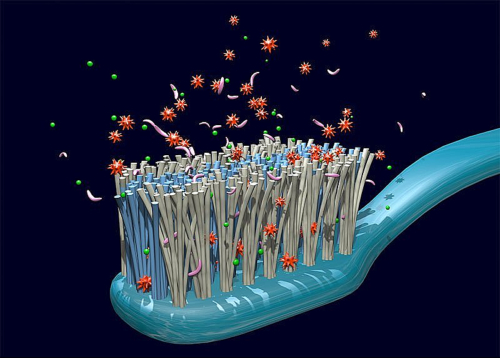As we age, oral health becomes more critical than ever. According to researchers, there can be as many as 1.2 million bacteria on a single toothbrush. Also, a New York State Dental Journal found that 70% of used toothbrushes are contaminated with these bacteria. What kinds of germs were discovered? Researchers have found the flu virus, staph bacteria, E. coli, yeast fungus, and strep virus hanging out on used toothbrushes. Studies also note that even after rinsing a toothbrush with just tap water, it can still be contaminated with microorganisms.
So, is your toothbrush making you sick?
Toothbrush bristles can become contaminated when they remove plaque and other soft debris from teeth. This can include bacteria, blood, saliva, or oral debris. And there is still a chance for the bacteria discovered on a toothbrush to break through our defenses. The bacteria in your mouth may also be linked to your cardiovascular health, including the development of heart failure and atrial fibrillation (an irregular and often very rapid heart rhythm).
According to Kimberly Harms, DDS, and a National Spokesperson and Consumer Advisor for the American Dental Association, “You’re putting bacteria on your toothbrush every time you brush your teeth.” As a result of this contamination, it is commonly recommended that folks rinse their toothbrush thoroughly with tap water after brushing. But can just using plain water to rinse off your toothbrush after use really cut down on bacteria and viral growth?
The bottom line, toothbrushes can still contain germs even after rinsing with just plain water that could raise the risk of infection, especially for seasoned folks. So, what can you do to prevent the further spreading of bacteria with your contaminated toothbrush?
- Avoid covering toothbrushes or storing them in closed containers, which can cause the growth of bacteria. If more than one brush is stored in the same holder, do not let them touch each other. Doing so is a great way to swap germs and keep your brush from properly drying.
- Like a medicine cabinet, it might seem like the bathroom drawer is the obvious choice for toothbrush storage, but it isn’t. The warm, moist environment is ideal for bacteria growth, and your toothbrush can become contaminated by other items in the drawer.
- Do not share toothbrushes. Toothbrushes can have germs on them even after rinsing that can raise the risk of infection.
- The American Dental Association recommends that you replace your toothbrush every 3-4 months whether or not you have been sick. Studies show that toothbrush bristles wear out with use, and after 3-4 months, they are not as effective in removing bacteria from your teeth.
- When you flush the toilet, bacteria or fecal matter become aerosolized, and that toilet spray can travel up to six feet, landing on the countertop, walls, floor, and your toothbrush. This phenomenon is known as toilet plume. Bacteria can cause serious gastrointestinal disease, that can be spread via toilet spray. “You don’t store your plates and glasses by the toilet, so why would you want to place your toothbrush there? It’s just common sense to store your toothbrush as far away from the toilet as possible,” says Gayle McCombs, RDH, MS, associate professor and director of the Dental Hygiene Research Center at Old Dominion University.
How to properly disinfect your toothbrush
What are the most efficient and inexpensive methods used to disinfect toothbrushes?
- Soak your toothbrush in 3 percent peroxide. A 2022 study shows that soaking a toothbrush in a solution of 3 percent hydrogen peroxide reduced the number of bacteria on a brush by 87 percent. While only 18% of the germs were eliminated by rinsing with ordinary tap water. Change the hydrogen peroxide daily before placing your toothbrush with the bristles first into the cup.
- To naturally disinfect your toothbrush, use baking soda. Stir one cup of water and two tablespoons of baking soda. Allow your toothbrush to soak in the solution for 15 minutes before letting it air dry.
- Soak your toothbrush in antibacterial mouthwash for 3 to 5 minutes at a time. Rinse thoroughly before using again. DO NOT gargle with the mouthwash you have used to disinfect your toothbrush, because of the bacteria it will now contain.
- Some websites recommend putting your toothbrush into the microwave oven or dishwasher to sanitize it. Although these methods will kill some of the bacteria, they will probably damage your toothbrush in the process. It’s better to just buy disposable brushes and throw them out.
And if you use an electric toothbrush, the heads are replaceable and can be cleaned and disinfected in the same way as a conventional toothbrush.
